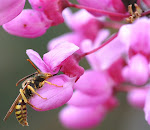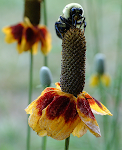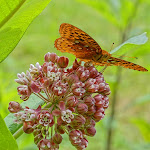Then: ta-daah! I opened them up to see how the bees were settling in. First thing I noticed was that both queens had been freed from their little isolation chambers. I could not find them in the throng of bees however, which made me feel quite amateurish. If you can't find your queen you can't know how things are truly going.
What I could see was lots of creamy white pure beeswax combs - especially in the blue Elizabeth hive. The bees had filled out all the frames in the box and were starting to make their own free-form comb in the empty box on top. The bees make long chains of bees when they do this, and when I lifted the top, to which they were stuck, they collapsed to the bottom in a shrill buzz. Definitely made them irked. But I smoked them and they all ran downstairs to the box below.
Smoke is an interesting tool for the beekeeper: when bees smell smoke, they turn and run into the hive. They are not "calmed" by smoke as some say, but actually set into alarm mode. The bees think their tree is burning down, so they go inside, put their heads in the combs and try to eat as much honey as they can. This way if they have to flee they'll carry provisions. All this preparation distracts them so that the beekeeper can disturb the hive without calling forth the troops (bees care more about the fire than they do about the irritating creature in white poking at them.
So after I smoked everyone out of the top box I added additional frames - now the Elizabeth hive has two stories. The green Kathryn hive is much smaller than Elizabeth. I thought I'd done a better job hiving the Kathryn bees (Elizabeth was first and I flailed around a bit with her bees). But Elizabeth's hive was flush and Kathryn's was small in comparison - and they were not done drawing out comb in the first story.
I have heard that sometimes when new bees are hived that they can drift between hives at first. Sometimes the bees have all come from the same previous hive and then won't stay separated into new hives but get back together in one of their new homes. It is mysterious.
Elizabeth bees are sugar syrup junkies too - they are downing jar after jar. They put a lot of it away in combs to feed what I hope are their incubating babies (couldn't see those either - I am failing on the two most rudimentary beekeeper tests!).
I also saw lots of pollen put away - and many bees coming in with laden saddle bags packed with bright colored pollen. The pollen colors are so various and sharp - my clever girls are finding their way around.




